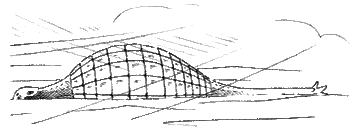
The head armor of the taranter is a horny covering that forms a grass-cutting beak along the edges of the broad mouth. Flat teeth in the back of the mouth grind up the plant food.
The taranter, Herbasaurus armatus, is an almost glyptodont-like ankylosaurine ankylosaurid from the steppes and grasslands of Central Asia in The New Dinosaurs: An Alternative Evolution.
In the windswept heartland of Asia, the continuous belt of coniferous forest is replaced to the south by cold grassland of mixed grasses and narrow-leaved flowering plants. At the forest edge the grasses are rooted in a rich black soil, but further south the soil is redder and drier. These grasslands are known as the steppe. Beyond the steppe a wilderness of drifting sand, hard-packed clay and shattered stone sweeps southwards to the foothills of the huge Himalayan mountain chain that partly marks the southern limit of the Palaearctic ecozone.
The steppe grassland is home to many small seed-eating burrowing animals, particularly placental mammals. Their burrowing way of life keeps the soil churned up and aerated and prevents all the rich topsoil of the surface layers from being used up too quickly. In this way the plant life is maintained. In the spring the steppe is a blaze of color as the flowering plants come into bloom, while in summer the feathery seed heads of the grasses create a totally different landscape.

Ankylosaur armor, consisting of mostly scutes and nodules, with large spines in some cases, evolved as a defensive mechanism. In the taranter it has become more important as a means of conserving moisture. Hollows inside the skull are lined with damp membranes that moisten the dusty air as it is breathed in. Defensive armor is still present as horny spikes along the flanks and the heavy club on the tail.
As in most of the great grasslands of the world, the steppe supports a variety of grazing animals, all of which have evolved since the Mesozoic era. The taranter is a species of ankylosaur, related to such extinct varieties as Euoplocephalus and Saichania that became so plentiful at the end of the Cretaceous period. The ankylosaurs were divided into two families. The first one, the nodosaurs (originating back in the Jurassic), were quite lightly built and came to their peak early in Cretaceous times. The more advanced ankylosaurid group were heavily built, with massive armor and a weapon on the end of the tail, and were successful after the first group began to decline in the earliest Neogene. Most of the ankylosaurs that exist today are descended from the heavily armored forms. They were always abundant in this part of the world and fossils reveal that they evolved into grazing animals as the grasslands developed. In the taranter the armor, developed from horn-covered bones set in the skin, has become a continuous covering for the back. This, and the bulbous shape of the body, help to prevent desiccation in the dry winds.

By settling down into a hollow and presenting its streamlined armored surfaces to the wind the taranter can withstand the stinging sand and dust storms that are common in the area.
